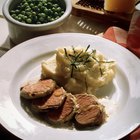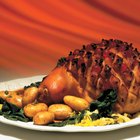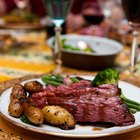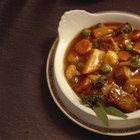
Rather than choose between serving beef or pork roast, you can roll them up and roast them together, making a beef-stuffed pork roast or a pork-stuffed beef roast. This requires two cuts that are similar so they cook evenly. Try cooking a pork shoulder roast with a beef rump roast, also known as a bottom round roast. These are both somewhat tough cuts of meat that should be braised to make them tender and to render the connective tissue and collagen throughout the meat. The two roasts are tied together to cook as a single unit.
Step 1
Trim each roast of excess fat on the outside. It's especially important to trim the fat from the smaller one. It's OK to leave some fat on the outside roast because the fat helps baste the roasts as they cook.
Step 2
Cut each roast in a spiral so it lays flat. Instead of trying to maneuver your knife in a spiral, make a horizontal cut, peel back the cut meat, make a vertical cut and peel back the meat, continuing until the roast lays flat.
Step 3
Rub herbs, spices and seasonings evenly over all sides of each roast. You can keep things simple with a sprinkling of salt and pepper, or try garlic powder, brown sugar, white pepper, cumin and cayenne pepper.
Step 4
Place the smaller of the two roasts on top of the larger roast. If you wish, spread cornbread stuffing, a mixture of chopped herbs or vegetables, or a similar stuffing on top of the smaller roast.
Step 5
Roll up the roasts from end to end so the end of the roasts looks like a pinwheel. Tie the roasts together with butcher's twine spaced every 1 1/2 inches along the length. Tie the first loop with a square knot. Make a large loop with the string, slip it over the end of the roast, sliding it up about 1 1/2 inches away from the first loop, and pull to tighten.
Step 6
Preheat the oven to about 300 degrees Fahrenheit. Adjust the rack to the center position.
Step 7
Set the rolled roast in a roasting pan. Add water or beef broth to line the bottom of the pan, covering no more than one-third of the roast. Cut up aromatic vegetables, such as onions, celery and carrots, to scatter around the roast, if you wish.
Step 8
Bake the roast for about 2 to 2 1/2 hours or until the internal temperature of the pork reaches a minimum of 145 F. Check the roast periodically and spoon the liquid over top to keep the meat moist. The exact cooking time depends on the weight of the roasts, generally about 30 minutes per pound.
Step 9
Insert a meat thermometer in the center of the roast to check the temperature. Beef can be cooked under 145 F, but the U.S. Department of Agriculture Food Safety and Inspection Service recommends 145 F as the minimum temperature for pork.
Step 10
Remove the beef-pork roast from the oven and allow the meat to rest for at least 3 minutes before carving so the juices redistribute throughout the meat. Cut the butcher's twine and remove it from the roast before carving into slices about 1 inch thick.
Related Articles

How to Cook a Bottom Round Roast on a ...

How to Bake a Pork Loin Center Half
How to Cook a Beef Florentine Roast

How to Cook Beef Top Round Pot Roast

How to Cook Tender Rolled Flank Steaks ...
How to Cook a Center Cut Sirloin of ...
How to Cook a Rolled Roast Medium Rare

How to Make a Juicy Pork Tenderloin

How to Cook a 15-Pound Rib Roast

What Does It Mean to Score Roast Pork?

How to Marinate Pork Chops in Pineapple ...

How to Cook Top Round Roast With ...

How to Trim and Tie a Beef Tenderloin

How to Carve a Bone-In Ribeye

How Do I Cook Boneless Pork Leg Roast ...
How to Slow Cook a Pot Roast With Beef ...

How to Turn a Chuck Roast Into Steak

How to Cook a Roast Beef on a ...

How to Cook a Neck Roast

Making a Cummerbund
References
- FoodSafety.gov: Safe Minimum Cooking Temperatures
- U.S. Department of Agriculture Food Safety and Inspection Service: Fresh Pork from Farm to Table
- U.S. Department of Agriculture Food Safety and Inspection Service: Beef from Farm to Table
- National Pork Board: Mushroom-Stuffed Pork Roast
- Fine Cooking: Tie a Rolled Pork Loin
Tips
- If you prefer your beef cooked less than well done, buy a beef roast that is smaller than the pork roast. This way, the beef is rolled inside the pork, where it takes longer to cook than the pork on the outside.
Writer Bio
A former cake decorator and competitive horticulturist, Amelia Allonsy is most at home in the kitchen or with her hands in the dirt. She received her Bachelor's degree from West Virginia University. Her work has been published in the San Francisco Chronicle and on other websites.
Photo Credits
Jupiterimages/liquidlibrary/Getty Images